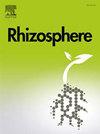与治疗癌症的细菌酶相比,通过植物分子农业提高大豆根瘤天冬酰胺酶的生化特性
IF 3.4
3区 生物学
Q1 PLANT SCIENCES
引用次数: 0
摘要
天门冬酰胺酶是一种用作抗癌剂的治疗酶,通常通过微生物发酵法利用大肠杆菌和欧文氏菌等生物生产。然而,这种方法面临着各种挑战,包括生产过程中可能出现的酶污染、对酶的过敏反应以及需要采取严格控制措施的稳定性问题。一种创新的解决方案是应用植物分子农业,利用根瘤菌根系共生生产天冬酰胺酶。我们的目标是优化结核发育以提高天门冬酰胺酶产量,确定酶的特性,并评估其对微生物酶的抗癌功效。在我们的研究中,我们建立了大豆根培养物,并接种日本农杆菌以形成根瘤。我们评估了不同培养时间下真核天冬酰胺酶的产量。我们从根瘤培养物中纯化了天冬酰胺酶,并将其理化性质和抗癌活性与微生物天冬酰胺酶进行了比较。结果表明,根瘤培养物中的天门冬酰胺酶在培养基中接种根瘤菌 10 天后达到最大活性。根瘤天冬酰胺酶表现出高含量的α螺旋和β片,以及低含量的无规线圈。与大肠杆菌天冬酰胺酶相比,它在不同的 pH 值和温度下都表现出更高的稳定性和活性。此外,与大肠杆菌天冬酰胺酶相比,根瘤天冬酰胺酶显示出更好的催化参数和长期稳定性。因此,作为一种抗癌剂,根瘤天冬酰胺酶优于大肠杆菌天冬酰胺酶。这确保了根瘤天门冬酰胺酶能够有效地靶向癌细胞,提高整体治疗效果。这为传统的酶生产方法提供了一种可再生、具有成本效益和环保的替代方法。本文章由计算机程序翻译,如有差异,请以英文原文为准。
Enhanced biochemical properties of soybean root nodule asparaginase through plant molecular farming compared to bacterial enzyme for cancer treatment
Asparaginase is a therapeutic enzyme used as an anticancer agent and is typically produced through microbial fermentation using organisms such as Escherichia coli and Erwinia chrysanthemi. However, this method faces challenges, including potential enzyme contamination during production, allergic reactions to the enzyme, and stability issues requiring stringent control measures. An innovative solution is the application of plant molecular farming, utilizing Rhizobium root symbiosis for asparaginase production. The objective is to optimize nodule development for asparaginase yield, characterize the enzyme's properties, and evaluate its anticancer efficacy against microbial enzyme. In our study, we established soybean root cultures and inoculated them with Bradyrhizobium japonicum to form root nodules. We evaluated eukaryotic asparaginase production at different incubation times. We purified asparaginase from the root nodule cultures and compared its physicochemical properties and anticancer activity with microbial asparaginase. Results showed that asparaginase reached maximum activity in root nodule cultures 10 days after rhizobium inoculation in the culture media. The root nodule asparaginase exhibited a high content of alpha helices and beta sheets and a low random coil. It demonstrated higher stability and activity across different pH levels and temperatures than Escherichia coli asparaginase. Additionally, root nodule asparaginase displayed better catalytic parameters and stability over time than E. coli asparaginase. Thus, root nodule asparaginase is superior to E. coli asparaginase as an anticancer agent. This ensures the root nodule asparaginase can effectively target cancer cells, enhancing the overall therapeutic outcome. This provides a renewable, cost-effective, and environmentally friendly alternative to traditional enzyme production methods.
求助全文
通过发布文献求助,成功后即可免费获取论文全文。
去求助
来源期刊

Rhizosphere
Agricultural and Biological Sciences-Agronomy and Crop Science
CiteScore
5.70
自引率
8.10%
发文量
155
审稿时长
29 days
期刊介绍:
Rhizosphere aims to advance the frontier of our understanding of plant-soil interactions. Rhizosphere is a multidisciplinary journal that publishes research on the interactions between plant roots, soil organisms, nutrients, and water. Except carbon fixation by photosynthesis, plants obtain all other elements primarily from soil through roots.
We are beginning to understand how communications at the rhizosphere, with soil organisms and other plant species, affect root exudates and nutrient uptake. This rapidly evolving subject utilizes molecular biology and genomic tools, food web or community structure manipulations, high performance liquid chromatography, isotopic analysis, diverse spectroscopic analytics, tomography and other microscopy, complex statistical and modeling tools.
 求助内容:
求助内容: 应助结果提醒方式:
应助结果提醒方式:


